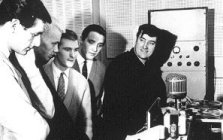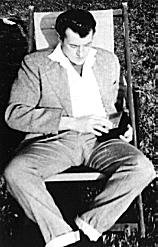|
Telstar |
||
|
While Joe was enjoying his first major success in Europe with "Johnny Remember Me", on the other side of the Atlantic the American company Bell Telephone had been secretly working on their new satellite idea, the Telstar Project. Telstar 1, the world's first communications satellite, went up at the beginning of July 1962. The event was so major that it was televised around the world, and on July 10th 1962, the first wobbly pictures bounced from an American TV camera to the orbiting satellite and back to a small TV in the corner of Joe Meek's living room. Joe, who only a couple of years previously had publicly predicted the advent of record players which required no needle or stylus cartridge, was moonstruck by this incredible thing and the first strains of his newest composition almost immediately started floating through his mind. In the middle of the night, songwriting partner Dave Adams was awoken with a desperate demand from Joe that he come and help him shape this tune. |
||
|
Although Joe had already written many - probably hundreds - of songs, he was essentially tone deaf, and although he could hear in his head exactly what the record sounded like before he'd even composed the melody, he was almost completely unable to communicate his musical ideas directly to the artists. Somehow Adams - and a few other musicians such as Geoff Goddard, arranger Charles Blackwell and a very young Ritchie Blackmore - was able to act as translators and it was for this reason that Adams became almost a co-writer for Joe's greatest hit, "Telstar" by The Tornados. Note by note, in the wee small hours of July 11th, Joe and Dave laboriously worked out the tune and within a very short time The Tornados were called to London during a short hiatus in their run of Summer season performances in Great Yarmouth. |
||
|
The Tornados had been formed by Joe as a studio session band, and were chiefly known at that time as Billy Fury's backing band. They were able to get the bulk of "Telstar", along with the rhythm track for the B-side, "Love & Fury", recorded in a mad rush before having to leave for their next Yarmouth performance, but what they heard before they left was very different from what hit No. 1. On leaving the studio, the rhythm, drum and bass parts were all done, along with the lead guitar breaks and the piano effects such as the harp-like glissandos at the top end of the range. What was still missing when their Yarmouth contract recalled them so rudely was the lead instrument on what would be called the verse, had there been any vocals. |
A publicity photo with The Tornados in the control room at 304 Holloway Road |
|
|
The final recording has been the subject of considerable controversy over the years, but it was Geoff Goddard who played the lead keyboard line, on a primitive electric valve-driven organ called a clavioline, which produced a reedy sound and was capable of playing only one note at a time. It was Geoff's habit of wordlessly singing to himself while playing which produced the unearthly vocal on the fade out. |
||
|
While this is not the place to go into the technicalities of analogue recording, it is worth noting that Joe was still working with at best a twin-track machine. "Telstar" is constructed from two drum tracks and possibly another of percussion, one or two bass lines, the rhythm guitar, the lead guitar, the piano, the clavioline, the vocal (which was possibly picked up by the clavioline mike) and the sound effects. In addition, there are still a few notes of Dave Adams' keyboard part, played on the Lowrey organ, faintly discernible in the guitar breaks although these have largely disappeared in the final mix. The mystery of exactly what went into the recording and the effects, and who really played the instruments, endures; in fact, not just on "Telstar" but on many of his more complex recordings, as he had the habit (and the means) of altering, overdubbing or even completely removing anything he wasn't entirely happy with and replacing it with something performed by any capable musician who happened to be hanging around at the time. |
||
|
By the beginning of 1963, "Telstar" was a million-selling No. 1 hit all over the world, not only in Europe but the Australias and, the golden prize of the British artist, America. One would think that the money would have started rolling in, setting The Tornados up for life and enabling Joe to improve his facilities beyond his wildest dreams. The fly in the ointment was a French composer named Jean Ledrut who, a few years before, had written the theme for a little known war film called "The Battle of Austerlitz". When it was obvious that sales of "Telstar" showed no immediate signs of abating, Ledrut made his move and sued Joe for plagiarism. The suit was to haunt Joe for the rest of his life; it was still not settled when he died and some would say that it was the beginning of his downhill slide. |
||
|
A rare candid shot, probably taken in Newent |
Ledrut's "Austerlitz" theme did bear a few notes resemblance to "Telstar", but then parts of both tunes are reminiscent of "Rule Britannia" and Mozart's "Hallelujah Chorus", which obviously predate M. Ledrut's obscure effort by many years. In fact it was only the order of the first seven notes of the main melody which were similar. After that, the two tunes diverged completely. The tempos, structure and arrangements were completely different, "Austerlitz" being a military march. The case went to trial in a French court, causing Joe even more headaches and necessitating retaining translators and lawyers. All royalties from "Telstar" were frozen as soon as the writ was issued, leaving Joe with no way to pay The Tornados or cover his own costs. The court case was a shambles; at one point Joe's musicologist demanded that a piano be brought into court in order that he could demonstrate the differences between the tunes. This he duly did, but then the trial faltered for the best part of two days because all the jurors wanted to play the piano. And the judge allowed them to! So much for the French legal system. |
|

